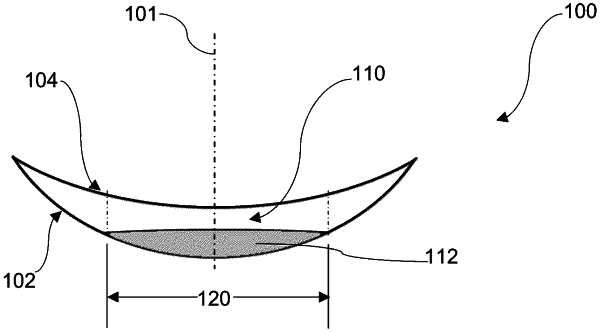| CPC G02B 1/043 (2013.01) [B29D 11/00057 (2013.01); B29D 11/00067 (2013.01); B29D 11/00134 (2013.01); B29D 11/00192 (2013.01); C08G 77/20 (2013.01); C08L 83/04 (2013.01); G02C 7/04 (2013.01); G02C 7/102 (2013.01); G02C 7/108 (2013.01); B29K 2083/00 (2013.01); B29K 2105/0061 (2013.01); B29K 2995/0018 (2013.01); C08L 2201/10 (2013.01); C08L 2203/02 (2013.01); C08L 2312/00 (2013.01); G02B 2207/109 (2013.01)] | 22 Claims |

|
1. A method for producing hydrogel contact lenses, comprising the steps of:
(1) obtain a first polymerizable fluid composition and a second polymerizable fluid composition, wherein the first polymerizable fluid composition comprises at least one visible-light free-radical photoinitiator, at least one thermal free-radical initiator, at least one first polymerizable material, and at least one photochromic compound, wherein the second polymerizable fluid composition comprises said at least one thermal free-radical initiator and at least one second polymerizable material and is free of any photochromic compound, wherein the first polymerizable fluid composition has a curing time as determined in photo-rheology study using a visible light at a specified intensity;
(2) obtaining a lens mold, wherein the lens mold comprises a female mold half having a first molding surface defining the anterior surface of a contact lens to be molded and a male mold half having a second molding surface defining the posterior surface of the contact lens to be molded, wherein the female and male mold halves are configured to receive each other such that a mold cavity is formed between the first and second molding surfaces when the mold is closed;
(3) applying an amount of the first polymerizable fluid composition onto a central zone of the first molding surface of the female mold half to form a circular layer of the first polymerizable fluid composition, wherein the circular layer has a diameter of about 13.00 mm or less;
(4) actinically curing the circular layer of the first polymerizable fluid composition to form a disk having curved surfaces, wherein the step of actinically curing is carried out by irradiating the circular layer of the first polymerizable fluid composition with the visible light at the specified intensity for at least 30% of the curing time;
(5) dispensing an amount of the second polymerizable fluid composition over a partially-crosslinked circular layer on the central zone of the first molding surface;
(6) closing the female mold half with the male mold half to form a molding assembly comprising the partially crosslinked circular layer immersed in the second polymerizable fluid composition within the mold cavity;
(7) thermally curing the second polymerizable fluid composition and the partially-crosslinked circular layer immersed therein in the molding assembly to form an unprocessed hydrogel contact lens having a central photochromic zone that has a diameter of about 13 mm or less, is concentric with the central axis of the unprocessed hydrogel contact lens;
(8) separating the molding assembly into the male and female mold halves, with the unprocessed hydrogel contact lens adhered onto a lens-adhered mold half which is one of the male and female mold halves;
(9) removing the unprocessed hydrogel contact lens from the lens-adhered mold half; and
(10) subjecting the unprocessed hydrogel contact lens to post-molding processes including a hydration process and one or more other processes selected from the group consisting of extraction, surface treatment, packaging, sterilization, and combinations thereof.
|